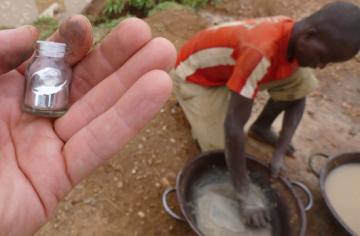Gold—good for development, toxic for children
- Tara Sharpe

For nearly two decades, UVic geochemist Dr. Kevin Telmer (earth and ocean sciences) has been working with small-scale and artisanal gold miners, whose practices can expose people and communities around the world to toxic levels of mercury and lead even while the rare metal itself means better livelihoods, healthier lives, and a chance at a more prosperous future for the miners and their families.
Telmer recently returned from northwestern Nigeria in his latest effort to help solve the global conundrum.
"In Zamfara, 100,000 miners can extract 10 tonnes of gold in one year and realize most of that profit," says Telmer.
"Unlike bananas, coffee or cotton, which bring in less than 10 per cent for workers and growers, with gold the miners are seeing direct returns of about 80 per cent."
This informal industry produces approximately 15 per cent of the world's extracted gold and is practised in 70 developing countries (mainly in Africa, Asia and Latin America) by 10 million people including an estimated 3 million women and children.
"They are still about 40 times poorer than your average Canadian, but incomes are much higher than from agrarian subsistence livings, and some make enough to send their children to school," says Telmer. "Small-scale gold mining is now a global movement. Big problems remain but it represents a huge global development opportunity."
In 1995, Telmer was a geologist working for the Canadian government, surveying the impoverished mining communities of Brazil and the environmental impacts of small-scale mining in the Amazon. That's when he joined the global effort, and then joined UVic shortly thereafter in 1999.
Mercury is a highly toxic metal that most people on this continent no longer even want in their dental fillings let alone on fingers or in their lungs. But that is often where it ends up in small-scale mining communities. The ancient method-used as a fast and cheap way to extract gold-was extensively used in the Canadian gold rushes.
The gold ore is ground up, then mercury is added to bind the gold into an amalgam; this is then heated to evaporate the mercury and gold is left behind. The mercury poisons the miners, the local community and environment, and travels around the globe contaminating the world's fisheries.
And in Zamfara, it's not just mercury. The world's worst-ever lead "epidemic" has already killed hundreds of children this year in that region. Telmer was in the northwestern state of Nigeria to assess the current system and design a safer mining program that will improve the health, social and environmental conditions of mining communities.
There, mercury is used but lead is the more acutely dangerous element: when gold is inappropriately ground out of the lead-rich ore using motorized flour mills, lethal dust is released into the air to poison the soil.
"Just like young Canadian children, Zamfaran kids ingest soil while playing outside," explains Telmer. "They're close to the ground and put their fingers in their mouths often. Those under five years old are eating approximately 1g of soil per day."
Telmer has partnered with the United Nations Environment Program and UN Industrial Development Program, the US Department of State, the World Bank, and many local NGOs in the past and has partnered in Nigeria with M&e#180;decins Sans Frontières, Blacksmith Institute (New York) and US environmental consultancy Terra Graphics to develop a solution they collectively refer to as a three-legged stool.
"It has to be a three-part approach," he says. "There is medical case management, which is emergency treatment for those already experiencing toxicity. This is accompanied by environmental remediation. And there is prevention-initiation of safer mining practices. That's where I come in. We focus on the origin of the problem."
This is the model applied wherever he visits. "But it's not always easy to convince miners to change something that produces quick cash."
The mill grinding process is very dusty. The short-term solutions are conceptually simple: use a wet processing method. Telmer assists with the set up, and in Zamfara, wet processing produces more gold-an easy sell. With the mercury, distillation can recycle 95 per cent of the heavy metal, resulting in 20 times less exposure. Meanwhile, M&e#180;decins Sans Frontières provides logistical support and works to get the cohort of miners and families into a healthier situation.
Telmer was in Nigeria for 15 days in July, and last month he visited Mongolia, which has roughly 100,000 small scale gold miners, and is soon headed back to West Africa to Burkina Faso, a neighbor of Nigeria, and then Nairobi in Kenya for the third round of negotiations on the UN's forthcoming global mercury treaty.
"We're experts, we Canadians," Telmer adds. "Gold is how most of the West was built. The Fraser River. The Klondike. It is a very Canadian industry and we're heavily involved to this day. A lot of the capital required for gold exploration is raised on our nation's stock market. And a lot of Canadian junior exploration companies use small-scale miners as an exploration tool-an ethically questionable practice. We can do better."
Telmer founded the non-profit Artisanal Gold Council (AGC), a local organization dedicated to improving the opportunities, environment, and health of the millions of poor people involved in artisanal and small-scale gold mining, and in doing so, improving the gold sector at large.
He is executive director, alongside fellow AGC board members Drs. Merwan Engineer and Paul Schure (economics), and Ms. Susan Keane, Senior Analyst at the Natural Resources Defence Council in Washington, DC. Telmer also serves as technical advisor to the UN on artisanal gold mining.
The AGC is in the early stages of setting up a corporate social-responsibility fund for the small-scale miners.




